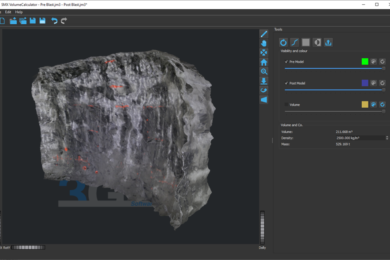3GSM GmbH, a developer of software to optimise blasting and reduce inherent environmental issues, has announced several updates to its flagship BlastMetriX UAV software that, the company says, improves communication with smart drills, offers face profiling enhancements and delivers more sophisticated drill pattern analysis.
Robert McClure, President of Robert A McClure (RAM) Inc of Powell, Ohio, an international blast and engineering consulting firm that provides service, support and training for BlastMetriX UAV, said: “3GSM works closely with its blasting customers to adapt to new challenges faced in the field and improve blast optimisation. Customers with an active update licence automatically receive these new features inside the BlastMetriX software, or they can be ordered separately.”
The enhanced drill pattern analysis tool provides heat mapping of drilled borehole deviations for simple visualisation of differences between “as planned” and “as drilled” patterns, while semi-automatic mapping of linear rock mass features is imported into the blast plan. By providing enhanced burden and spacing information, the software allows users to adjust explosive amounts in each borehole to account for irregularities, according to the company. “This is a great tool for a company’s key performance indicator program,” McClure said. “The software captures information from each blast and allows users to go back and review historical data to correct issues in the field.”
Updates to the IREDES (International Rock Excavation Data Exchange Standard) interface improves two-way data communication between BlastMetriX UAV and smart drills. It now allows for import of measure for drilling data like drill penetration rate and air pressure to map the subsurface geology of the borehole. At a quick glance, the software shows the geology and burdens from borehole top to bottom out to the free face. The program is compatible with all major drilling equipment manufacturers, according to the company.
Incorporating the ShapeMetriX system for generating and assessing 3D images, new geological mapping integration allows users to better visualise dips, strikes, seams and voids throughout the drilling pattern. The software can characterise irregularities in the face, which are projected back through the borehole. This allows for more precise loading of the borehole and improves blast safety.
In another update, the underground volumetric measurements tool inside ShapeMetriX now provides the determination of precise volumes in a “generalised” manner, based off captured subsequent tunnel faces and perimeters.
With the aid of aerial targets or standard BlastMetriX targets as reference points, the software imports images from a calibrated DSLR camera or unmanned aerial vehicles to quickly, safely and accurately capture 3D face profiles for enhanced visualisation of the blast area. Multiple data-rich overlapping images generate hundreds of thousands of data points for accurately characterising typography of the surveyed area and creating a 3D face profile.
BlastMetriX UAV gives technicians the confidence the blast will perform as designed to mitigate fly-rock issues, high air overpressures, excessive vibration, poor fragmentation, sub-par cast, loss of grade control and wall damage, the company says.
“Through blast design optimisation using BlastMetriX UAV, operations can realise significant benefits including improved fragmentation, higher crusher throughput and lower drilling man power requirements,” 3GSM said. “The scalable BlastMetriX UAV software allows companies to integrate as much or as little technology as required.”










